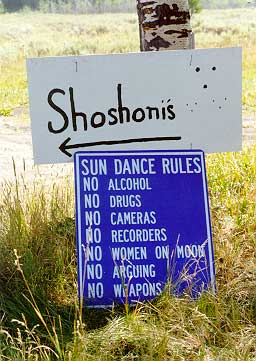Sacred Journey
Integrated Seminar 101 Section 4 Honors
Fall Semester 2015
 |
|
Entrance Sign Shoshoni Sun Dance, July 2000 source: Frey 2000 |
I'm your instructor, Rodney Frey. You are always welcome in my office. I look forward to visiting with you. You can contact me at:
Voice: 885-6268
E-mail: rfrey@uidaho.edu
My Home Page: www.webpages.uidaho.edu/~rfrey
Your Peer Mentor for this seminar is Trevor Moss. You can contact him at:
-
E-mail: moss6813@vandals.uidaho.edu
Our textbooks to be used for Fall are:
-
Shri Purohit Swami, translator. Bhagavad-Gita. Skylight Paths, 2001 (ISBN 1893361284)
-
Sohaib Sultan, translator. The Qur'an and Sayings of Prophet Muhammad. Skylight Paths, 2007 (ISBN 1594732221
-
Rodney Frey, Lawrence Aripa and Tom Yellowtail, ed. Stories That Make the World: Oral Traditions of the Indian Peoples of the Inland Northwest. University of Oklahoma Press, 1995 (ISBN 0806131314)
Primary Textbooks:
Common Read: Anthony Doerr. All the Light We Cannot See. Scribner, 2014 (ISBN 1476746583)
Supplemental
Readings:
Class Session days, times, and locations:
Class Times: Tuesday and Thursdays 8:00 - 9:15
Classrooms: TLC 141
Office Hours:
My office is in Phinney Hall, Rm.116, with office hours on Mondays and Wednesdays 9:30 to 12:00, or by appointment.
Go to:
Schedule of Topics, Assignments and Session Dates - - A Map of Our Journey
Course Description - Nature of our Pilgrimage
Leaning Outcomes - Upon Reaching the Summit of Your Pilgrimage
Learning Activities - Skills and Competencies Needed to Reach the Summit
Study Guide for Exams and Pilgrimage Edicts - Assistance Along the Way
Course Resources - More Assistance Along the Way, includes a Bibliography for Projects
Course Description: Throughout history and in the varied societies of the world, sacred journeys within the world’s great spiritual traditions have been at the foundation at providing spiritual and cultural significance and meaning to life, and of creating community. Sacred journeys go to the heart of what it means to be "human." During this semester we will consider the sacred journeys embedded in Indigenous (Coeur d'Alene and Crow Indian), Hindu, and Muslim communities.
|
|
|
Benares - Pilgrimage to this Sacred Hindu City |
Sacred journeys are of many different types and serve a variety of essential roles. In this course we will consider two distinct, though interrelated, forms of sacred journeys. There are sacred journeys that are of a personal nature. These journeys include various "rites of passage," such as spiritual quests, initiations into religious orders or statuses, states of illness and healing, and the final rite of passage, death. Sacred journeys can also be of a collective nature. These include groups of people journeying to sacred places, which can be either spatially or temporally oriented. Spatial journeys are illustrated in "pilgrimages" involving travel to a "sacred place," such as to Benares or to the Medicine Wheel in the Bighorn Mountains. Temporal journeys are illustrated in the act of storytelling and in certain communal rituals, often referred to as "world renewal ceremonies," in which time is suspended and participants return to "the perennial time of the creation."
While all sacred journeys travel over and through an exterior landscape, seeking to discover the divine in a temple, or at a sacred site such as Benares in India, all sacred journeys are fundamentally focused on the interior journeys of the soul and spirit, realizing the divine within oneself. We will discover that all sacred journeys are essential to and shared by all religions throughout time and throughout the world today.
It is through the sacred journeys of the great religions and embedded in their sacred texts that each religion facilitates access to and disseminates their quintessential teachings and truths. Among the sacred texts we will engage are the Bhagavad-Gita, Qur'an and Salmon Always Goes Up River. For each of the religious communities we will encounter on our travels this semester, we will explore their great teachings.
While there are certainly uniquenesses that distinguish one tradition from the next, we will discover that all the religious traditions have at their core certain essential truths that are shared in common. To frame our quest to learn of these shared truths, we will seek to understand how each religion identifies: 1. the nature of the ultimate divine, 2. the supreme sacred goal and realization in life and death, 3. the means to attaining that goal, the routes to ascendancy, enlightenment, and/or redemption, as well as 4. the sacred landscape upon which one travels to the goal. In addition, this course will address how each religion addresses the nature and role of compassion, forgiveness, and suffering, and the quintessential question, why do bad things happen to good people?
Before we begin our journey and to better equip you for it, we will develop your learning skills in "Huckleberrying" and entering the "Tin Shed." We will provide an academic research and learning technique (as distinguished from a theological approach) that allows you to interpret religious symbols, values and stories based upon a distinct yet integrated humanities and social sciences methodology. Also known as Eye Juggling. As you consider various sacred texts throughout this course, such as an oral narrative or a ritual dance, interpreting these texts will allow you to better understand the meaning embedded within them. It is a methodology that allows you to get a little closer to seeing the world's sacred journeys from the perspectives of the adherents themselves. And as a consequence, by juxtaposing what can be unique and distinct alongside what is often veiled and taken for granted, one also can more clearly reveal and appreciate your own religious values.
While our study of religion will be conducted within a scholarly venue, seeking academic objectives, the sacred journey will not and can not be divorced from your own personal quest. We will learn the value of and attempt to integrate together, both "head" and "heart" knowledge. This course, as with your entire freshmen experience, is itself a special sort of "rite of passage," within which you will receive many powerful "gifts, and journey on your own unique educational pilgrimage in search of your own "special place." Cherish all the "gifts" that are bestowed on you, gifts from your class experiences, as well as outsider the classroom. They will serve you for a life-time.
This seminar is the foundational entry course into the University of Idaho’s General Education curriculum. The U of I General Education curriculum emphasizes a multi-year, broad liberal education. It is a curriculum conceptually and pedagogically integrated, beginning with the ISEM 101 Integrated Seminars; then between their first and third years students bridge into the five skills and perspectives curricular components of Communication, Science, Math, Humanities and Social Science, and American Diversity and International; the integration is then reiterated with the ISEM 301 Great Issues seminars, and culminates with the Senior Experience. The Integrated Studies component of ISEM 101, ISEM 301 and Senior Experience is specially designed to be educational points of General Education integration. Infused throughout this curriculum are the shared Learning Outcomes of the University of Idaho, which are reflective of the unique mission of the University of Idaho, and consistent with the Essential Learning Outcomes of LEAP (Liberal Education and America’s Promise; see http://www.aacu.org/leap/). It is a General Education curriculum which complements and is cohesive with a student’s major field of study, and not a standalone, ‘check-off-the-box’ educational experience.
Learning Activities and Grade Distribution: This is a course modeled as a rite of passage and a pilgrimage. As such, it is a course that requires your participation. You can not assume a passive observer's role, viewing the sacred journeys from afar. To help you stay on course and reach your destination, you will need to adhere to the "Pilgrimage Edicts" of this course. You will be expected to complete the following Learning Activities. Each of these Learning Activities are in turn linked to the Learning Outcomes of this seminar and this university.
Assessing the Growth of the Neophytes (three exams - 45%)
Personal Quest (individual or small group participatory paper - 30%)
Class Pilgrimages (in-class discussions and reflective writes - 25%)
Grade Distribution: Your final grade will be based upon the total points earned from the #2 participatory project (3 points for proposal, 2 points for outline and 25 points for project, for total of 30 points), the #1 exams (45points; 15 points for each of three exams), and #3 discussion groups, in-class discussion and reflective writes (25 points; 3 points for the approximate twelve to fifteen writes/discussions). In cases of boarder-line decisions, your class attendance, as well as questions and discussions brought up during class, will be taken into consideration. Three or more unexcused absences can tip the scales. The following scale will determine your grade: 90-100 (90%-100%) = A, 80-89 (80%-89%) = B, 70-79 (70%-79%) = C, 60-69 (60%-69%) = D
| Study Guide | Resources | Frey's Home Page |
You are currently viewing http://www.webpages.uidaho.edu/~rfrey/101.htm
Page manager: rfrey@uidaho.edu
